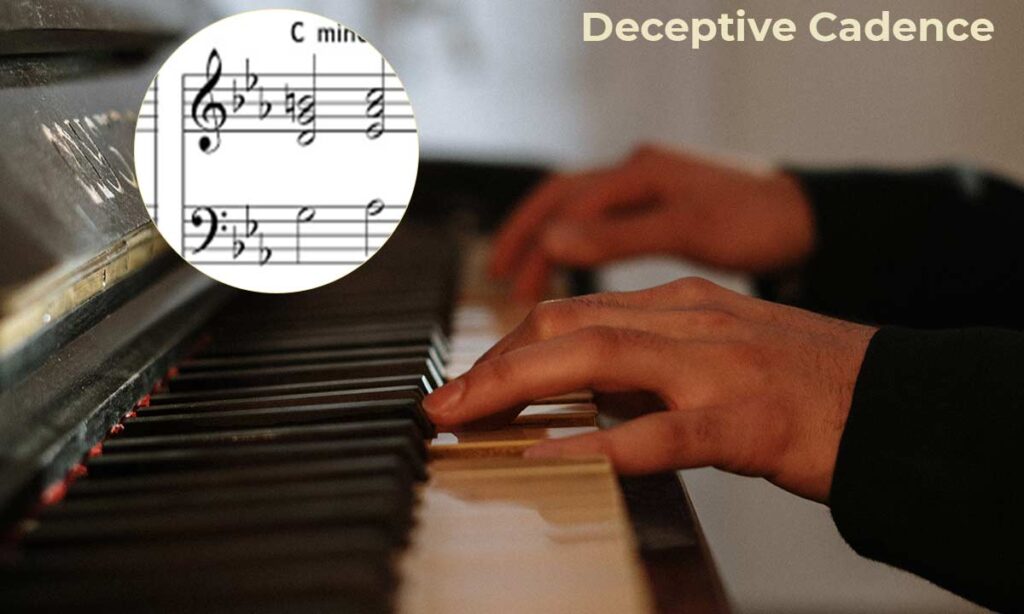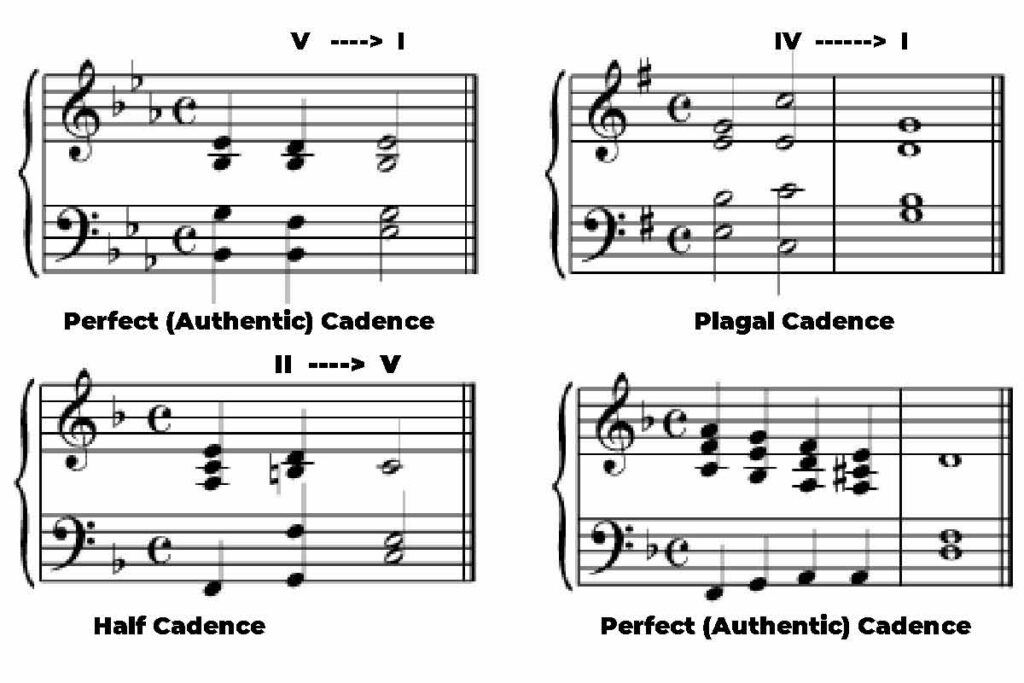The Quick Guide To Deceptive Cadence In Music

Introduction To Deceptive Cadence In Music
Deceptive cadence is one of the four common types of cadences that we have in music theory. It is referred to as an incomplete cadence because of the way it sounds at the end of a musical phrase.
Although we have discussed the deceptive cadence briefly in types of cadences in music. Notwithstanding, we are going to discuss it in more detail here.
Before we go into the business of discussing deceptive cadence in detail, let us remind ourselves that cadence is used to establish a sense of ending at the end of a musical phrase.
However, the end result of a deceptive cadence is not completely resolved. This means with deceptive cadence, the phrase is intriguing with a feeling that projects the continuation of a piece.
This is not like authentic cadence and plagal cadences that give us a sense of completion at the end of a phrase. Both authentic and plagal cadences unlike deceptive cadence end a musical phrase completely without imposing any feelings of continuation.
Specifically, this post is to throw more light on what deceptive cadence is in music theory.
So in this article, we will look deeper into what is deceptive cadence in music theory. Also, we will also discuss the chords needed to form deceptive cadence.
Moreover, for a better understanding of deceptive cadences, we will use different examples in our article. But before then, let us quickly discuss and remind ourselves what is cadence in music theory.
What Is Cadence in Music?

Cadence is basically the ending part of a musical phrase, section, or entire piece of music usually in the form of chord progression. In comparison with the speaking or written languages, cadence is the punctuation point in the music.
In a simple term, cadence is used in music to satisfactorily end the piece or a phrase of music. It is a conclusive resolution used to signify that the piece has come to an end.
A cadence utilized a combination of chords to bring a phrase, section, movement, or the entire piece of music to an end. Majorly, it used the last two chords that end a phrase in music.
Absolutely, cadence is a very important part of music composition. Especially in ending the musical phrase in the right way to project the right feelings of the composer’s mind.
We can read what we need to know about cadence to know more about what cadence is in music.
Although we have different types of cadences in music that we can use to properly bring desired closure to an end of a phrase. However, four out of them are the most commonly used.
What Are the Four Types of Cadences?
Basically, we have four common types of cadences in music. In no particular order, the four common types of cadences we have are listed below.
- The Authentic Cadence
- The Plagal Cadence
- The Half Cadence
- The Deceptive Cadence
We can use any of these four types of cadence to create different senses of ending in a piece of music.
Absolutely, there is a suitable cadence to raise or create tension within a musical context. Also, there are cadences that are suitable to close the end of a phrase smoothly to end a section or the entire piece.
As a matter of fact, we could achieve any feelings we wanted to create at the end of a phrase.
Either we wanted to create tension or smoothly close a phase. What is required is a chord progression peculiar to the cadence, best fit for the feeling we wanted to create.
For instance, the plagal cadence will smoothly close the entire piece with its progression from chord IV to chord I. And the ending will sound satisfactorily closed as we normally have it in hymns ending with AMEN.
As we have known, each type of cadence creates a different feeling when used at the end of a musical phrase.
So composers are using them to ensure the final ending of their phrases sounds absolutely right. And create the right feel they wanted to create.
One of the most common ways to create a particular feeling at the end of a phrase is using a deceptive cadence. In the next section, we will learn more about deceptive cadence and how to use it in music.
What Is a Deceptive Cadence?
Deceptive cadence is the cadence that progresses from the dominant chord and does not end on the tonic chord. Specifically, it moves from the dominant chord (V/v) and ends on any other chord besides the tonic (I/i) chord.
Deceptive cadences are special cadences with chord progressions that project a conclusive phrase that will never come.
The way it sounds always adds an undeniable element of unforeseen progression at the end of a musical phrase.
Moreover, they are referred to as one of the weakest cadences because they project the feeling of incompleteness.
For instance, going from (IV) to (V) and ending on (VI). At the chord V of the progression, the cadence will sound as if it wanted to go home (i.e. tonic).
This will sound exactly as we have chord (V) to (I) in the perfect cadence but will finally end on a different chord like (VI/vi).
Progression from the chord (V) to (I) is typically the perfect cadence that sounds strong and firm. And hearing the chord V will actually project the feeling of a chord (I) as the next chord to close the phrase.
But deceptive cadence will finally end on different chords like (VI). In other words, the chord will sound false and create deception as well as unexpected resolution.
These are the reasons deceptive cadence is also called interrupted cadence, false cadence, or avoided cadence. All because they give us a deceptive resolution.
What Is a Deceptive Resolution?
Deceptive resolution is a tonal resolution that occurs when a dominant or dominant seventh chord is resolved into a non-tonic chord.
Deceptive resolution is what we experience when we are expecting a tonic chord (I) after hearing (V) or (V7) chord to have a perfect cadence.
However, the expected chord (I) would be replaced by chord (vi) and resulted in smashing our perfect cadence expectation.
For instance, in the key of C major, we have heard the dominant seventh chord which is the chord of G7.
And our sense of listening is expecting it to resolve to the tonic chord which is a chord of C.
But it resolves on the chord of A which is a submediant chord or other chord besides the chord of C. This will give rise to a deceptive resolution which will give our sense of listening to an apt surprise.
The resolution was called deceptive because our sense of listening was deceived as a result of interrupted or broken expectations.
What does a deceptive cadence resolve to?
A deceptive cadence resolves to a chord that is not a tonic chord. This is opposed to what we usually expected a dominant chord to resolve to.
In particular, the deceptive cadences normally resolve to the tonic note that uses different tonic chords. This indicates that the harmony of the tonic used is not the main tonic triad. Nevertheless, the tonic note is part of the triad.
Basically, deceptive cadences in major keys resolve in minor submediant (vi) chords and ones in minor keys resolve in major submediant (VI) chords.
What chords does a Deceptive cadence use?

The Deceptive cadence is commonly resolved on a submediant triad/chord which is also known as a chord (VI/vi). This means that (V/v) chord followed by (vi/VI) chord.
However, it can end on any chord besides the tonic. That means any chord other than chord (I). Specifically, it sometimes resolves on other chords like subdominant (IV).
For instance, if we are in the key of C major, the fifth scale degree will be G, and we will have “G, B, D” as G triad. Also, the sixth scale degree will be A and we will have “A, C, E” as a triad of A.
Even if it is resolved on the chord (IV/iv) we will still have a tonic note. In particular, the fourth scale degree is F in the key of C major and the triad of F will be “F, A, C“.
So, if we want to have deceptive cadence on the key of C Major we will use a chord of fifth followed by a chord of sixth. That is G – B – D followed by A – C – E as shown in the diagram above.
Note that C is the tonic of the key of C major and we have that C in the ACE that the cadence resolves to.
Nevertheless, a deceptive cadence sometimes ends on a chord that does not contain the tonic or part of the original key.
This normally projects a change in the key of the music or tonality of the music generally known as modulation.
How Deceptive Does Cadence Sound

Listen to the sound and feel the cadence. You will clearly feel the surprise progression in the second chord progression.
The first chord progression is perfect cadence with a chord (V) followed by chord (I). The chord sound finished as you hear it again and again because the chord returned home.
The second chord progression is the deceptive or interrupted cadence with a chord (V) followed by a chord (VI). It does not actually taken us home, or it did?
The second chord progression somehow lifted the phrase and because we are expecting the tonic, it slightly surprised us.
With the feelings of the final sound, we will actually need some notes to follow the cadence. This is very obvious because we cannot end the phrase like that.
So the chord of fifth followed by the chord of sixth works perfectly for deceptive cadence. Typically, the chord progression from (V) to (VI) is the classical music standard and not always the case in popular music.
Using The Deceptive Cadence In music
Deceptive cadence is a common technique used in different compositions starting from the Baroque era and beyond the classical era.
The interrupted cadence is actually a non-conclusive or unfinished cadence.
In addition, it does not sound final or conclusive at the end of a phrase like we have in authentic or plagal cadence.
For this reason, we do not use them to end or conclude a tonal work.
However, deceptive cadences are commonly used to create repetitive links between two phrases of a similar melody. This can be experienced in binary form and sometimes in the repetition of the last verse line of a song or hymn.
Also, deceptive or interrupted cadences are employed in instrumental music to develop the melody line further and satisfactorily close the music context.
Triad of deceptive cadence

Generally, we do not need to use the triad of fifth and sixth in typical chord form.
So we can have the triad of fifths in C Major which is “G, B, D” in different ways. For instance, we can have G – D – B like G3 – B3 – G4 – D5 or as G3 – G4 – B4 – G5 and so on.
Also, we can have the triad of sixths in C Major which is “A, C, E” in several ways. For instance, we can have A –C – E like A3 – C4 – E4 – C5 or as A3 – E4 – C5 – E5 and so on.
Therefore, we can have deceptive cadence like (G3 – B3 – G4 – D5) – (A3 – C4 – E4 – C5) or (G3 – G4 – B4 – G5) – (A3 – E4 – C5 – E5).
If we play the sound, you will note that the cadence will not take us home as expected with deceptive cadence. However, we will be able to create an end that will allow us to continue with the music.
Also, we should avoid using deceptive cadence in the first inversion. Simply because of its similarity to the tonic chord. That is a chord of I, which is built on the key of the music.
So, it will cause the cadence to sound as if we play a wrong tonic chord (chord I) rather than a submediant chord (chord VI/vi).
Deceptive Cadence Examples

We can find a typical example of deceptive cadence in Saint Bees’s hymn. The score we have above is in the key of A-flat Major. J. B. Dykes (1823 – 1876).
The example shown in the diagram above contains the deceptive cadence in the third phrase before the music finally resolves with an authentic perfect cadence.
If we play the sound of the notes shown in the example above, we will notice that we could not really stop at that point.
So we need to go further, add another phrase, and finish it with perfect cadence.
What we have here is the movement from dominant seventh in A-flat Major to Submediant. That is Eb – G – Db – B chord to F – Ab – C – Ab chord.
As we can see, we have the A-flat Major tonic note but not its tonic triads or chord.
At Phamox Music, we go all out for exactness and honesty. For this purpose, if by any means you found any possible glitch, be it factual, editorial, or something that we need to update, kindly contact us.
If you find the information provided in this post “Deceptive Cadence In Music” interesting and helpful, kindly share it with someone you know that might need it.








Great explanations, except you have A as the vi chord, but it’s actually A minor and a lower case vi for the deceptive cadence.